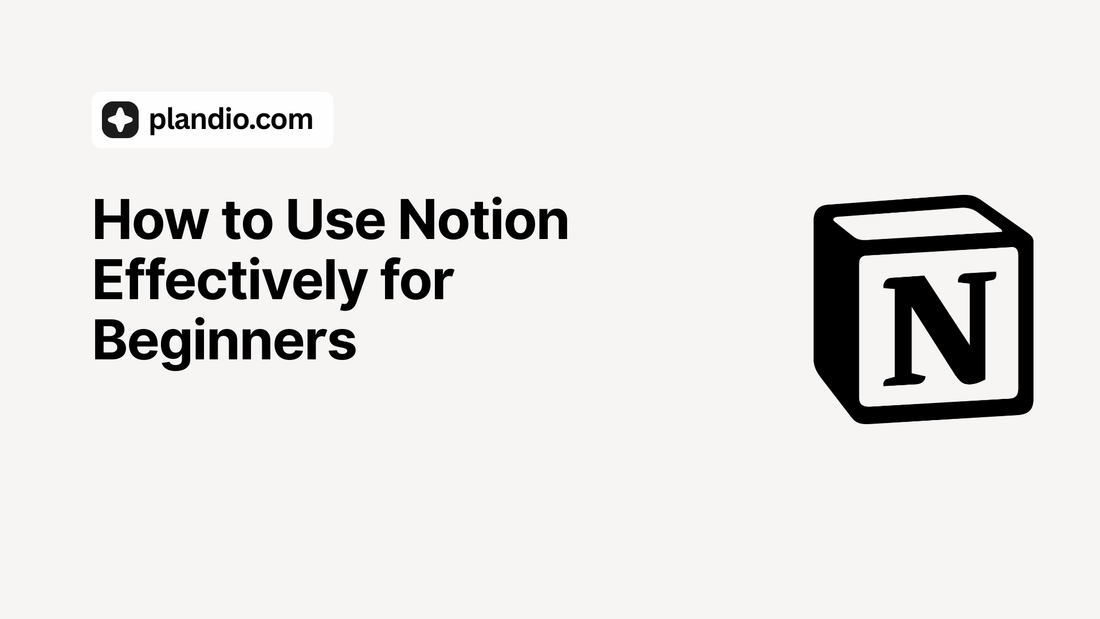How to Use Notion Effectively for Beginners
Share

If you’ve just discovered Notion and want to learn how to use it effectively, this guide will walk you through everything you need to know — from the basics to advanced tips. Notion isn’t just another note-taking app. It’s a powerful all-in-one workspace where you can plan projects, manage tasks, write notes, and organize every aspect of your personal or professional life.
1. What Is Notion?
Notion is an all-in-one productivity platform that combines note-taking, task management, databases, and wikis in one unified workspace. You can create pages, connect them with databases, and customize your workflow freely. Notion works across web, desktop (Windows, macOS), and mobile (iOS, Android) with automatic syncing across all devices.
Instead of juggling between multiple tools like Google Docs, Trello, or Evernote, Notion allows you to build your own system — whether for personal productivity, studying, or team collaboration.

2. Getting Started with Notion
To start using Notion, visit notion.so or download the desktop/mobile app. After signing up, you’ll see a simple and minimalist interface consisting of:
- Sidebar: Your main navigation panel to manage pages and workspaces.
- Pages: Each page can contain text, images, to-do lists, tables, or even subpages.
- Blocks: The basic building unit in Notion. Every paragraph, image, checklist, or database item is a block that can be rearranged freely.
This modular structure gives you the flexibility to design your workspace exactly how you want.

3. How to Create and Use Pages
Click “+ New Page” in the sidebar to create your first page. You can use it for journaling, project planning, study notes, or goal tracking. Every element you add is a block. Type / to open the command menu and insert content easily.
- /text – Add a paragraph or note.
- /todo – Create a to-do list.
- /table – Insert a simple database table.
- /image – Add an image or screenshot.
- /page – Create a nested subpage.
You can move blocks around, duplicate them, or convert them into other types — giving you complete creative control over your content layout.

4. Using Notion Templates
Notion provides hundreds of free templates to help beginners get started faster. These templates save you time by offering pre-built structures for planning, studying, or managing finances. You can find them by clicking “Templates” in the sidebar or browsing the Notion Template Gallery.
Some useful templates for beginners include:
- Weekly Planner – Plan your weekly schedule.
- Habit Tracker – Build consistent habits.
- Finance Tracker – Manage income and expenses.
- Reading List – Track your books and reviews.
- Personal Dashboard – Create an overview of your goals and daily tasks.
Once you find a template you like, click “Duplicate” to copy it to your own workspace and customize it freely.

5. How to Organize Your Workspace
One of the most powerful aspects of Notion is how easily you can organize information. For new users, it’s best to start with a simple structure before adding complexity. Here’s a recommended setup for beginners:
- Dashboard: Your main hub linking to all key pages.
- Goals: Record short-term and long-term goals.
- Tasks: Manage daily, weekly, or project-related tasks.
- Notes: Keep all ideas, research, or references in one place.
- Finances: Track budgets, savings, and monthly spending.
With this simple structure, you can manage both personal and professional information without feeling overwhelmed.
6. Working with Databases in Notion
Databases are what make Notion truly powerful. They allow you to store, organize, and analyze data in different views. Each row represents an item, and each column is a property (like tags, dates, or checkboxes). You can use filters and sorts to keep your view clean and relevant.
Notion offers multiple database views to visualize your information:
- Table view: A traditional spreadsheet-style layout.
- Board view: A Kanban board for managing tasks and projects.
- Calendar view: A date-based layout for planning events or deadlines.
- Gallery view: A visual layout with image cards.

These flexible views let you customize how you manage everything — from daily tasks to content calendars.
7. Collaborating with Others in Notion
Notion is designed for teamwork as well as personal use. You can invite others to view or edit your pages by clicking the “Share” button in the top-right corner. Choose permission levels such as “View,” “Comment,” or “Edit.”
All changes happen in real time, making Notion an excellent tool for remote teams. You can mention teammates using @username, comment on blocks, and track progress collaboratively without needing extra tools like Google Docs or Trello.
8. Tips for Using Notion Effectively
- Start small: Don’t try to build a complex system right away. Begin with 2–3 pages and expand gradually.
- Use templates: Templates save time and provide structure.
- Leverage search: Use Quick Find (Ctrl + P / Cmd + P) to locate pages instantly.
- Favorite key pages: Pin important pages to the sidebar for quick access.
- Try Notion AI: Use AI features to summarize text, brainstorm ideas, or rephrase content.
9. Why You Should Use Notion
Notion gives you complete freedom to design your own productivity system. Unlike rigid tools, it adapts to your workflow instead of forcing you into predefined templates. Whether you’re a student, freelancer, or business owner, you can create a setup that fits your needs perfectly.
Once you understand the basics — pages, blocks, and databases — you can scale your system to manage everything: goals, finances, projects, or even a company wiki. The key to using Notion effectively is consistency and gradual optimization.
Conclusion
Learning how to use Notion effectively takes a bit of time, but the results are worth it. Start small, explore templates, and build your own structure step by step. Over time, Notion becomes more than just an app — it becomes your personal operating system that helps you stay organized, productive, and focused every day.